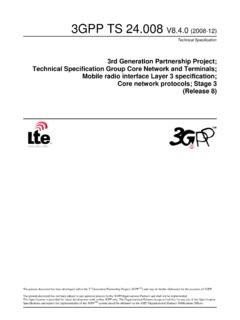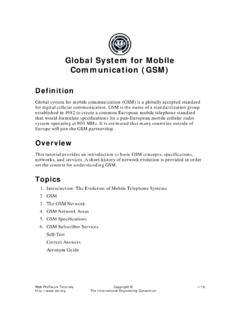Transcription of Protocol Signaling Procedures in LTE - Radisys
1 White PaperCONTENTSN etwork Architecture pg. 2 Bearers in LTE pg. 2 System Information Broadcasting pg. 3 Tracking Area Update pg. 7 Mobile -Originated Data Call pg. 8 Mobile Initiated Data Call Termination pg. 9 Paging pg. 9 Mobile Terminated Data Call pg. 10 Conclusion pg. 10 References pg. 11 OverviewThe exploding growth of the internet and associated services has fueled the need for more and more bandwidth. Handheld devices are growing exponentially and thus the need for the services on the move has increased tremendously. Current 3G technology is able to cope with the demand to some extent but unable to satisfy the needs Term Evolution (LTE) promises higher data rates, 100 Mbps in the downlink and 50 Mbps in the uplink in LTE s first phase, and will reduce the data plane latency and supports interoperability with other technologies such as GSM, GPRS and UMTS.
2 Plus, LTE has support for scalable bandwidth, from to 20 MHz. All these features make LTE a very attractive technology for operators as well as the this paper we briefly touch upon the Procedures executed by LTE user equipment (UE) and the various LTE network elements in order to provide the services requested by the Signaling Procedures in LTEBy: V. Srinivasa Rao, Senior Architect & Rambabu Gajula, Lead Engineer2 Protocol Signaling Procedures in LTE | Radisys White PaperNetwork ArchitectureIn Figure 1, the architecture of the LTE network is given with the various interfaces between the network elements; GERAN and UTRAN networks are shown for functions of the various network elements are: eNodeB: Radio Resource Management functions, IP header compression, encryption of user data streams, selection of an MME, routing of user plane data to S-GW, scheduling and transmission of paging message.
3 MME: NAS Signaling (eMM, eSM) and security, AS security, tracking area list management, PDN GW and S-GW selection, handovers (intra- and inter-LTE), authentication, bearer management. S-GW: The local mobility anchor point for inter-eNodeB handover; downlink packet buffering and initiation of network-triggered service requests, lawful interception, accounting on user and QCI granularity, UL/DL charging per UE. P-GW: UE IP address allocation, packet filtering and PDN connectivity, UL and DL service-level charging, gating and rate 2 shows the Protocol stacks at various LTE network in LTEIn LTE, end-to-end bearers are realized by the EPS bearers, which are a collection of radio, S1 and S5/S8 bearers. An EPS bearer identity uniquely identifies an EPS bearer for one UE accessing via E-UTRAN. The EPS Bearer Identity is allocated by the MME and is the one that carries the information; usually it carries the user are three kinds of bearers in LTE: Radio Bearers, S1 Bearers and EPS Bearers as depicted in the Figure 3.
4 In the UE, the uplink TFT maps a traffic flow aggregate to an EPS bearer in the uplink direction and in PGW the downlink TFT maps a traffic flow aggregate to an EPS bearer in the downlink direction. There is much more complexity than what is summarized here, but for brevity s sake it suffices to say that traffic off-loaders Figure 1. LTE Network ArchitectureFigure 2. LTE Control/User Plane Protocol StacksFigure 3. LTE Bearer Architecture3 Protocol Signaling Procedures in LTE | Radisys White Paperclassify traffic streams using DPI and then, based on the operator s policies, offload part of the traffic directly onto the Internet while sending the remaining traffic to the core network. Traffic off-loaders typically will be deployed as bump-in-the-wire boxes between the radio access network (RAN) and the core network (CN); in the future, some Radio Network Controllers (RNCs) might include this functionality inside the box.
5 Radio Bearer: A radio bearer transports the packets of an EPS bearer between the UE and an eNodeB. S1 Bearer: An S1 bearer transports the packets of an EPS bearer between an eNodeB and a S-GW. S5/S8 Bearer: An S5/S8 bearer transports the packets of an EPS bearer between the S-GW and the PDN is a one-to-one mapping between radio, S1 and S5/S8 bearers; this end-to-end EPS bearer realizes the negotiated QoS for the Information BroadcastingTo get service from the network, a UE has to select the network and camp on a cell. For this to happen, the UE has to synchronize itself with the network at the frame and slot level. Afterward, it requires the information like Network ID (PLMN ID), Tracking Area ID, Cell ID and the Radio and Core Network capabilities for its network selection. The network broadcasts this information to help the UEs in their selection LTE network supports broadcasting of System Information in the form of MIBs and SIBs; Figure 4 outlines the system information broadcast procedure.
6 Once the UE is synchronized with the network at the frame and slot level, it reads the broadcast information and selects it (PLMN and cell selection). MIB contains cell bandwidth and information about PHICH and the SFN. SIB contains list of PLMN IDs, TAC, CellId, CSG Identity (optional), neighbor cell information, etc. eNodeB will get most of the elements from the MME in an S1AP MME Configuration Update Message on the S1 interface as shown in Figure 5. This happens after the S1 interface establishment between eNodeB and 4. System Information BroadcastFigure 5. MME Configuration Update Procedure4 Protocol Signaling Procedures in LTE | Radisys White PaperRandom Access Procedure System AccessThe UE can utilize the services of the network once it is synchronized in both the downlink as well as the uplink direction.
7 After the PLMN and Cell selection, the UE is synchronized with the network in the downlink direction and now it needs to synchronize with the network in the Uplink direction. The Random Access Procedure (RAP) over PRACH is performed by the UE for this purpose; RAP is characterized as one procedure independent of cell size and is common for both FDD & TDD. There are two types of RAPs: contention-based and Random Access ProcedureIn this mode, multiple UEs may attempt to access the network at the same time, thereby resulting in collisions. The contention is resolved among the contending UEs in the following 4-step process (Figure 6): Step 1: Random Access Preamble on RACH in uplink Preambles are grouped based on the size of the L3 message the, UE would like to transmit; this provides an indication of resource requirements for the UE to the network.
8 Step 2: Random Access Response generated by MAC on DL-SCH This is an indication to the UE that the eNode B received its Preamble and conveys the resources reserved for this UE. Step 3: First scheduled UL transmission on UL-SCH The UE sends the RRC Connection Request using the resources given by the eNodeB in Step 2. In the RRC Connection request message, the UE sends its identifier to the network and it is used by the eNodeB to resolve the contention in the next step. Step 4: Contention Resolution on DL The eNodeB echoes back the received UE identifier to resolve the contention, and at this point the UE which has received its ID continues with the transmission while others will back off and try Random Access ProcedureThe network initiates this procedure in case of a handover of a UE from one eNodeB to another in order to keep handover latency under control.
9 It usually reserves a set of RACH preambles for this purpose and will transmit one from that group to the UE. There are no collisions with other UEs because the eNodeB controls the procedure, which is shown in Figure the UE receives the assigned RA Preamble, it sends it to the eNodeB which responds back. Steps 3 and 4 given in the contention-based RAP are not required 7. Non-Contention-Based Random Access Procedure Figure 6. Contention-Based Random Access Procedure5 Protocol Signaling Procedures in LTE | Radisys White PaperRRC Connection and Initial Attach ProcedureAfter the Random Access procedure, if the UE is not already attached to the network it has to do so by initiating the attach procedure. Otherwise, the UE initiates the tracking area update if it changed its tracking area since the last update.
10 For initiating any NAS procedure, the UE is required to establish an RRC connection with the eNodeB. The purpose of this procedure, depicted in Figure 8, is to request the resources from the network for its service needs. RRC connection establishment involves Signaling Radio Bearer 1 (SRB1) establishment. The procedure is also used to transfer the initial NAS message from the UE to the MME via the eNodeB, the latter of which does not interpret the NAS Attach ProcedureTo get NAS-level services (for example, internet connectivity) from the network, NAS nodes in the network have to know about the UE. To facilitate this; the UE has to initiate the Attach Procedure, which is mandatory for the UE at power on and also during the initial access of the the attach procedure succeeds, a context is established for the UE in the MME, and a default bearer is established between the UE and the PDN GW and an IP address is allocated to it.









